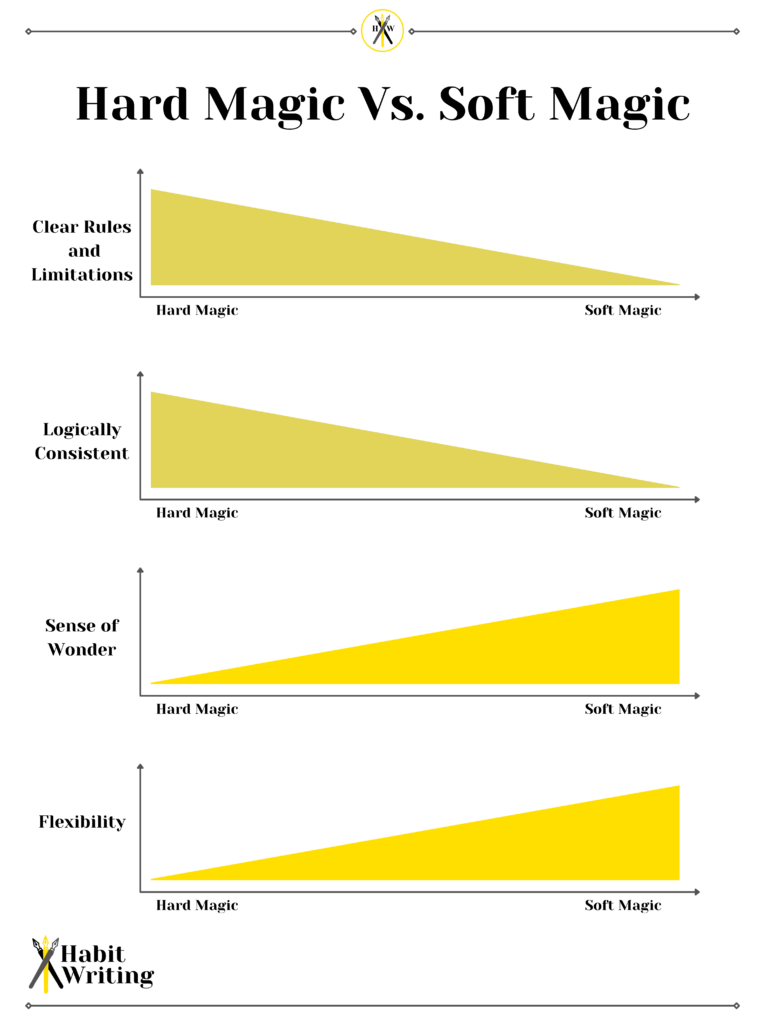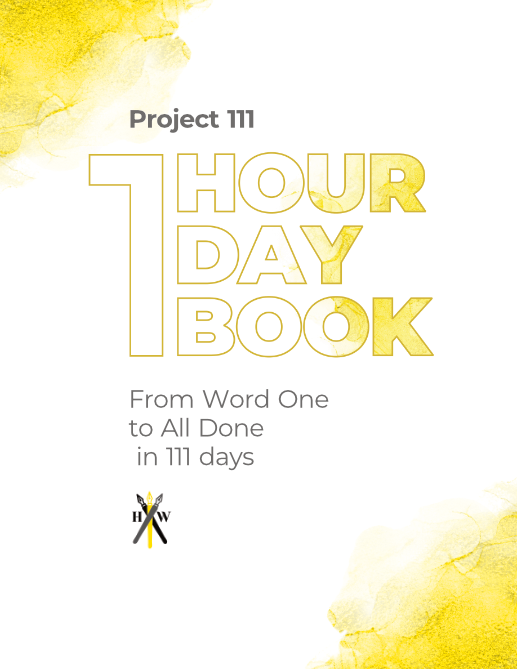“Hard magic” and “soft magic” were coined by the bestselling fantasy author Brandon Sanderson. He uses these terms to explain how magic is applied in fantasy fiction and how that affects the story that is being told.
Definitions:
Hard Magic System: A type of magic that has specific rules that the reader understands and which limit a magic user in what they can do.
Soft Magic System: A type of magic that–though rules may apply to it–does not have specific limits that are expressed to or known by the reader or audience.

As you’ll note above, the key difference between the two types of magic hinges on the reader’s understanding rather than the magic itself. The real key to these magic systems depends on how the magic is used and explained to the reader. You can have as many rules as you’d like in your fantasy story, but if your reader doesn’t know about them, then your magic system is not functioning as a hard magic system, no matter the number of clear rules you have in your notebooks.
But the big question is which one is right for your story? Or should you go for the elusive, hybrid magic system? Below we will explore the strengths and weaknesses of each and figure out how to make your magic work for your story.
Also, check out these 7 Magic System Ideas to help with your magic system and world-building.

Hard Magic Systems: Satisfying Solutions
A hard magic system is a rational magic system. This type of magic creates clear conflict and limitations. Hard magic services your story by limiting your characters and therefore providing challenges.
A great example of this is Brandon Sanderson’s The Stormlight Archive. (In fact, most of Sanderson’s stories hinge on some kind of hard magic.) In this story, certain magic users can take in an energy source known as Stormlight to do various incredible things. Those abilities stop, however, once the Stormlight runs out.

So that provides a whole plethora of interesting problems. When a confrontation arises but there is limited Stormlight, how will the character manage their limited supply? What happens when they run out? Where can they get more? Sanderson uses similar types of conflicts and problems in the Mistborn trilogy and other stories.
Hard magic systems work well because they allow your reader to be a part of solving the mystery or winning the fight. It makes your magic a puzzle to be solved, both by your characters and your readers.
There isn’t a feeling of deus ex machina because the problem’s solution has already been explored and explained to your audience throughout the story.
This type of magic relates closely to hard science fiction. What makes hard science fiction so interesting is that characters are bound by the laws of physics (for the most part). A hard set of physical boundaries limits the solutions available to the heroes, but makes it oh so satisfying when they piece things together to bring about a happy ending.
In the book series The Expanse, one of the most fascinating obstacles is that people can only travel as fast as the human body can accelerate. This and other physical restraints create constant friction between the characters and these laws of physics that bind them.
Compare that to Star Wars. The Force can mind trick plastic-coated soldiers, turn an old man into a ghost, lift a starfighter, and guide some ion torpedos down a very narrow shaft. That is a very different experience and, arguably a soft magic system, which we will explore in the next section.

Apply The Expanse logic to your magic system. As the esteemed Arthur C. Clarke put it, “Any sufficiently advanced technology is indistinguishable from magic.” Likewise any magic, that is well understood, documented, and explained, serves as science and technology within the fantasy genre.
So whether it’s alchemy, a spell book, or your own original idea, a fantasy writer using hard magic must express the rules of the system to the reader. This improves an author’s ability to resolve conflict in interesting ways because they are bound by the understanding of the reader.
Is a hard magic system right for your world? That’s for you to decide, my fellow writer! If you feel this will serve your story well or if you enjoy a more rigid, structured magical ability in what you read, then hard magic is a great place to start. Here are some pros and cons to help you determine the magical fate of your fictional world.
Pros and Cons of Hard Magic
| Pros | Cons |
|---|---|
| Strict rules and limits make magical conflict resolution more satisfying. | Adding new abilities can sometimes frustrate readers and break promises. |
| Readers feel they have a deep understanding of the magic. | Readers are less likely to be awed by the wonder of your magic. |
| Magical interactions have clear abilities so stakes are easily set. | story twists are often bound by the system rules and must be logical. |
Soft Magic Systems: A Sense of Wonder and Awe
As you have probably already imagined, the soft magic system serves functions and works in ways opposite to that of a hard magic system. If a magical world is filled with awesome marvels, then that is likely more of a soft magic system.
This is not to say that a sense of awe cannot be conveyed if rules are applied to magic, but typically the value of a soft magic system is in its sense of wonder and mystery. There will always be more to discover and surprises for your characters.

For example, In the quintessential, magical world of Harry Potter, you’ve likely heard of some inconsistencies found within the magic and its uses. This is because the purpose of the magic system is to be wondrous and to serve the plot of each book. So, new elements are often added (such as time travel) that, when looked at with a critical eye, don’t hold up.
The point of a softer magic system is not to have rules nor to always be internally consistent. In all honesty, Harry Potter is more of a hybrid magic system, but we will delve more into that in the next section.

A really good example is Gandalf from Lord of the Rings. If the story needs eagles, Gandalf can bring eagles. If the story needs someone to face the Balrog, Gandalf has got enough magical prowess to face a literal demon spawn of hellfire. (I recognize that this is because Gandalf is a Maia sent from Valinor to combat Sauron and the forces of evil. Also his real name is Olórin, which is just a cool name.)
The narrative objective of these powers is to invoke pure awe and wonder. His powers are of mythical proportion and when he is around, you feel safer. This is why, when the Fellowship has to go on without him, it serves the story and the characters really well. The remaining members of the fellowship have to continue moving forward, even though they don’t have Gandalf, the one who always seemed to have the right answer or the right ability to solve problems.
The downside, of course, is that soft magic can feel like deus ex machina. If there is a problem, then we can Gandalf it away. This is not always the case, but there is a sense that things will be alright if Gandalf is around. Nevertheless, it still serves the story in interesting ways.
When Gandalf is actually worried about something, the audience knows there is real cause for alarm. But sometimes, magical solutions really can feel like they have been generated out of thin air. (But I fully believe that the eagles could not have brought the ring to Mordor, because they too would have been tempted by its power, and taken it for themselves like giant feathered Isildurs).

Typically if powers seem relatively limitless, it’s a good idea to restrict how many people have limitless power. Now those characters can be taken out of the scene, killed, or otherwise indisposed to really add tension to a moment. Soft magic is a great compliment to characters who don’t know about the magic and can express the wonder and awe that you want your readers to feel.
So if you want your system to leave your readers wondering what other magical feats are possible, soft magic is the way to go. But remember to take these tips from stories where it is done well.
Here are some pros and cons to soft magic systems:
Pros and Cons of Soft Magic
| Pros | Cons |
|---|---|
| Provides a powerful sense of immersive mystery and wonder. | Can lead to deus ex machina, or feeling like conflict resolution is contrived. |
| Soft magic can grow and explore new facets as the story progresses. | Each new area of magic introduced may require new explanations. |
| Allows authors a wide range of flexibility with their magic. | Without strict limits, internal consistency can be challenging. |

Our 84-page book planner and 111 day writing course.
Hybrid Magic Systems: Finding Balance
Now on to the elusive hybrid magic system. I say elusive because this one doesn’t get talked about as much, but in reality, most magic systems are a mix of hard and soft. The truth is that the idea of hard magic vs soft magic is a false dichotomy. There are more options than one or the other and it’s nearly impossible for one to exist without elements of the other. Magic systems, therefore, end up on a spectrum, rather than an “either/or.”

These two ends of the magic system spectrum can interact in multiple ways. The first is the use of multiple magic systems in a story. A great example is in the Kingkiller Chronicle books by Patrick Rothfuss. Different types of magic exist within the series universe. One that is often used by the protagonist is Sympathy, which has specific rules about how and when it can be used. Those who use Sympathy essentially force their will and transfer energy by splitting their mind. The rules are explained and it’s clearly defined what someone can do with Sympathy. This type of magic lies on the hard magic end of the spectrum.
But another type of magic in the story is Naming. If someone can call something by its name, such as the wind (hence the title, The Name of the Wind), then they can manipulate that essence. The rules and bounds of the magic are fuzzy and wondrous, even to the extent that those who become proficient at Naming can go mad. This is a softer magic system. They both provide depth and meaning to the story but do so in very different ways.

Or, going back to Harry Potter, a magic system can mix solid rules and fuzzy boundaries for an interesting effect. So when a spell is used by a witch or wizard, that spell has an effect and a certain cost associated. For example, on must master the action of “swish and flick” to levitate an object. A spell is hard magic – direct input equals direct output. Faulty input, faulty output. (Poor Neville!)
But then you throw in Dumbledore and things get crazy. While some of The Headmaster’s tricks get explained, most of his spells remain mysterious and impressive. He can do amazing things that are unimagined and unexplained and any explanation comes well after the spell was performed. Even then, we don’t question what isn’t explained! This blended approach leads to some amazing moments which allows the audience to know what it means when someone yells “stupify,” but to also be surprised by whatever magical feat Dumbledore performs.

Determining your Magic System
There is a valuable lesson to learn from analyzing other magic systems that you have loved. But when you are developing your own, where do you start? Well brushing up on Sanderson’s laws can help you determine the limits and purpose of your magic. And we’ve got a step-by-step guide that will help you piece together your magic systems.
Remember that first and foremost, simpler is often better. Then go with whatever excites you most to write about. Figure out the bounds and depth of the magic in your fantasy world as you go, or plan it all out from the beginning. It all depends on the type of writer that you are, and what makes you most motivated to write.
Reed Smith
Reed is the founder and builder of Habit Writing and enjoys all things writing. He loves learning about the craft of storytelling, writing messy drafts, and playing board games with his wife, friends, and family.
Our 84-page book planner and 111 day writing course.



